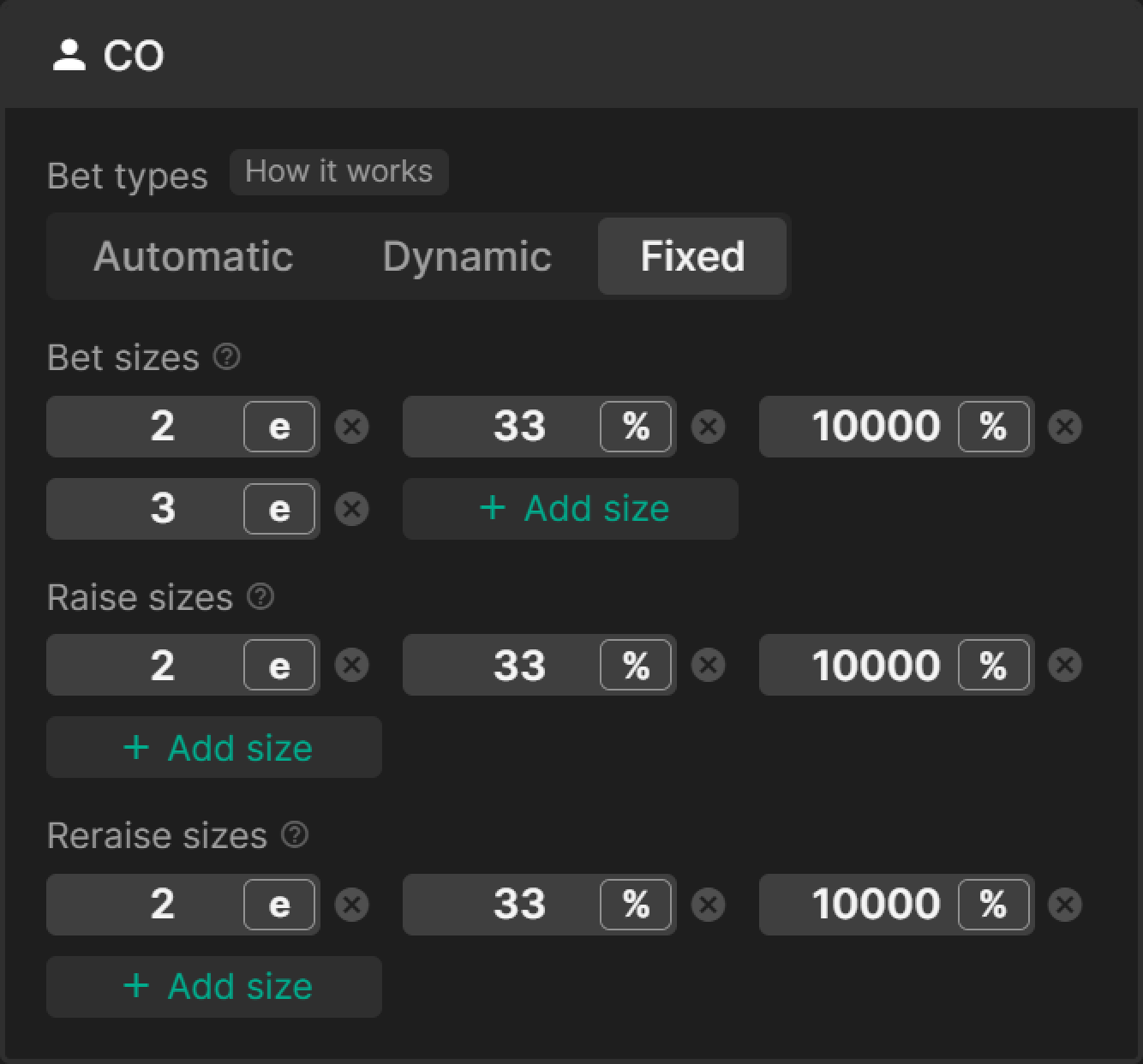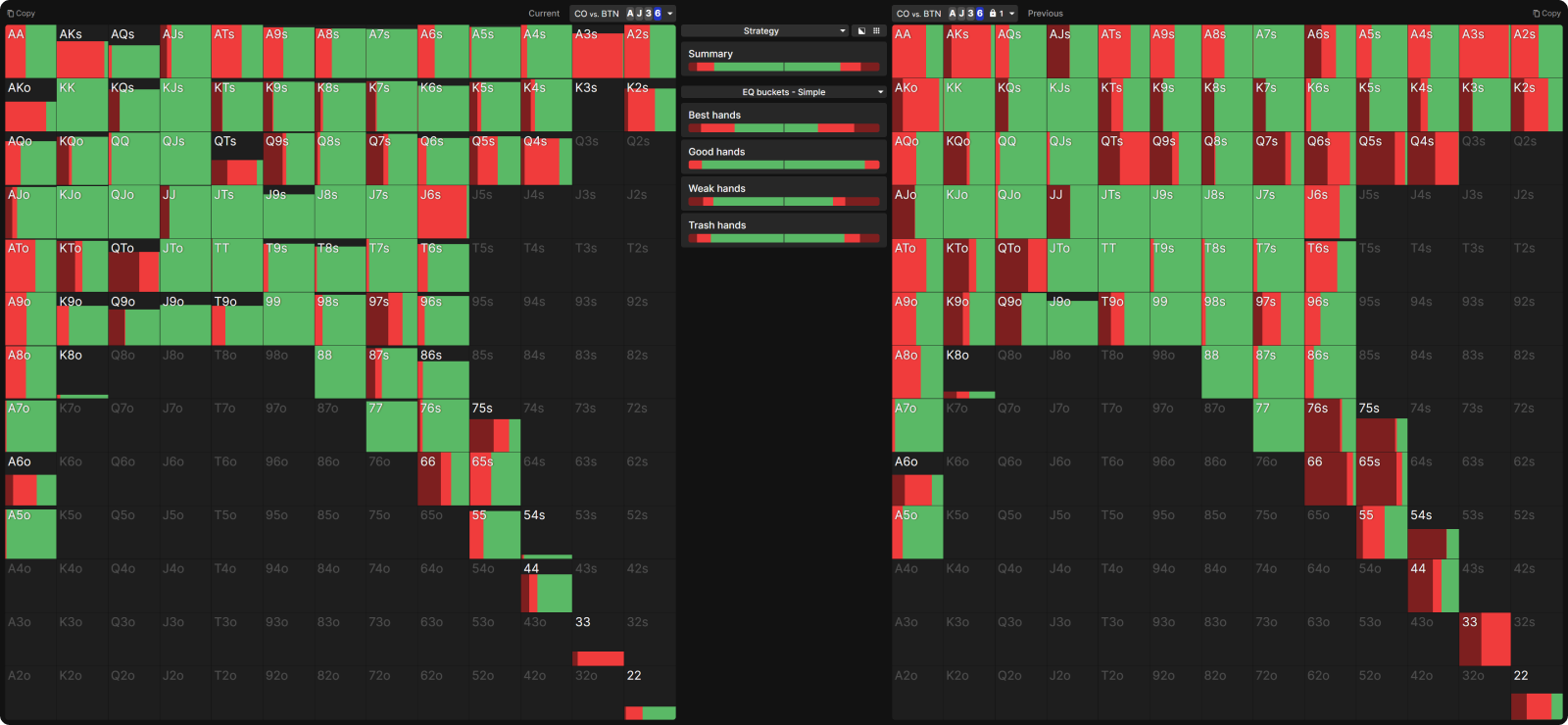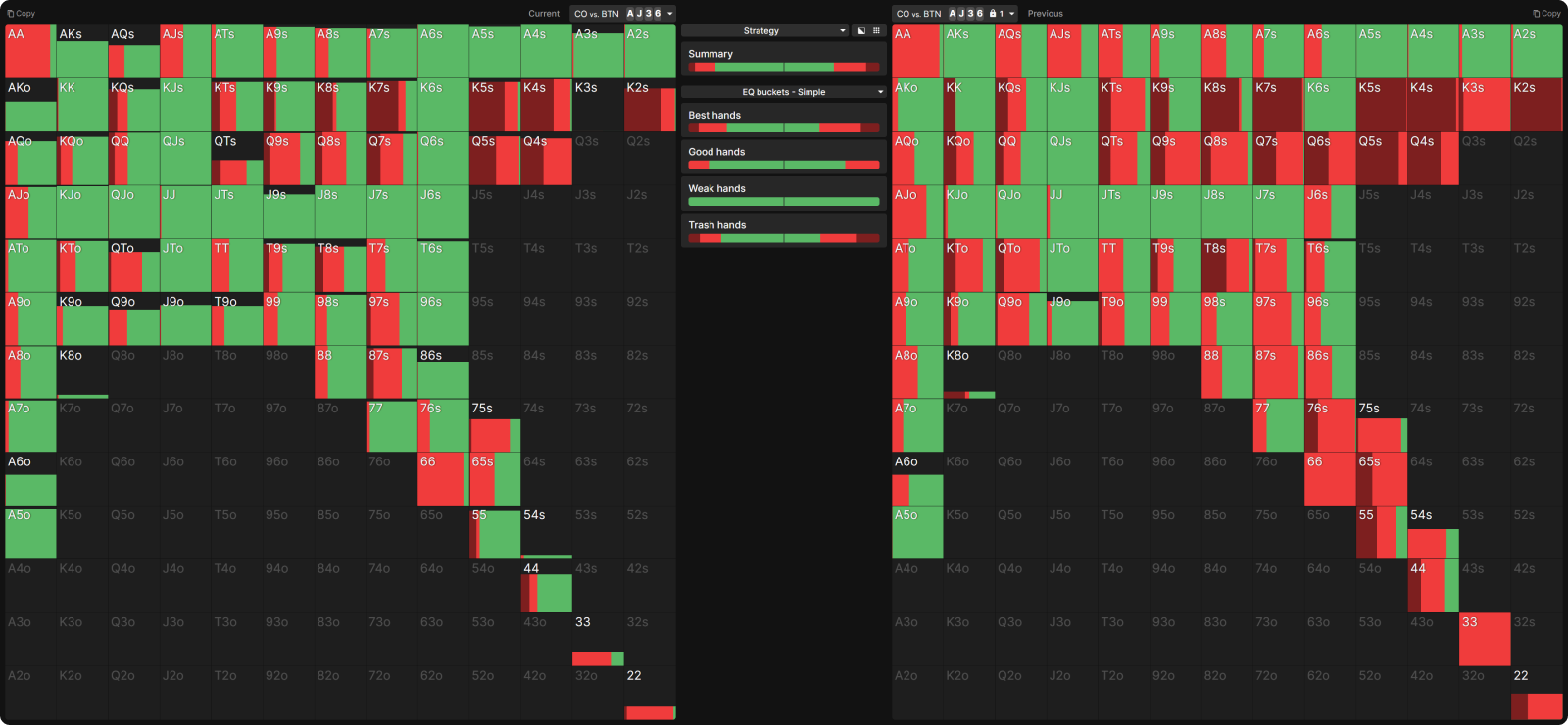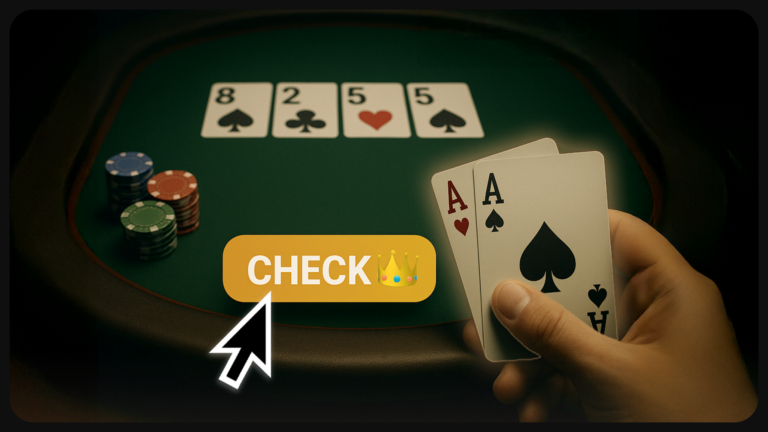Exploiting Cold Callers Who Stab Too Much
In single-raised pots (SRPs) between an in position (IP) raiser and an out of position (OOP) caller, there is usually a clear relationship between one player’s aggression and the other’s passivity. Typically, the OOP caller checks most or all of their range to the IP raiser, who then bets most of their range. The rare cases where the IP player is not incentivized to bet so often are also the cases where their opponent bets most frequently.
There is usually a clear relationship between one player’s aggression and the other’s passivity.
This is not the case for SRPs where the caller is in position. In those cases, solvers often recommend a high flop checking frequency from both players.
Despite what the solver recommends, many humans take a check from the raiser as a green light to bet. And they are not necessarily wrong to do so if their opponents check an unbalanced, overly weak range.
As with any deviation from equilibrium, however, they are opening themselves up to exploitation. In this article, we will examine how to exploit opponents who bet (stab) the flop too often IP when checked to by the OOP preflop raiser.
The Experiment
To see how your flop strategy should change to exploit an over-aggressive cold caller, we’ll need to use custom solutions and nodelocking. That means we won’t be able to look at reports to see the aggregate strategy across all flops. Instead, we’ll look at a few carefully chosen flops and extrapolate from there.
To begin, we’ll look at a CO vs BTN MTT ChipEV scenario with 40bb stacks. Ultimately, we will extract heuristics that will be useful in other structurally similar scenarios, but this is a good one to investigate as it is among the most commonly occurring cold-call spots. MTT ChipEV simulations include more cold calling than Cash simulations, and CO vs BTN is the spot you will find yourself in most often.
We will use a custom solution where players are allowed to bet 33% pot, a three-street geometric size, a two-street geometric size, or all-in on the flop, with similar options on later streets:
We will compare CO’s equilibriumEquilibrium
Refers to “Nash equilibrium” which is a stable set of adversarial strategies where no player can gain by unilaterally changing their own strategy. Therefore, the strategies have reached a balance, an “equilibrium”. strategy, on a few representative flops, to their exploitativeExploitative Strategy
A strategy designed around exploiting the mistakes of your opponents. Often used in contrast to GTO, which is designed to decrease the exploitability of your own strategy. See: MES/Nemesis. strategy when BTN is nodelocked to check half as often as they would at equilibrium.
- First, we will look at AJ3m, BTN’s most checked flop at equilibrium. Halving BTN’s checking frequency on this flop will necessitate a huge increase in their betting frequency, leading to dramatic and easy-to-observe patterns in CO’s maximally exploitativeMaximally Exploitative Strategy (MaxES)
A strategy that will perfectly maximize value by taking advantage of all your opponent’s mistakes. See: Nemesis strategy strategic response. - Secondly, we will look at one of BTN’s most bet flops (JJ3tt) to see whether those patterns hold up in a case where frequent betting is a much smaller mistake. It turns out that simply changing the Ace to an offsuit Jack creates such a flop, providing an easy, apples-to-apples comparison.
BTN’s Most Checked Flop: A♠J♠3♠
AJ3m is one of those flops that both players should check very often. Even though BTN should rarely bet when checked to, CO nevertheless checks nearly 90% of their range:
After CO checks, BTN’s equilibrium strategy checks back 75% of hands. When it does bet, it uses 63% pot (the three-street geometric sizing) exclusively:
This makes sense for a static board. BTN can predict with a high degree of accuracy what their hand value will be on the river and has little interest in protection betting, so when they do bet, it’s immediately polar, with an eye toward getting stacks in across three streets.
Facing such a polarized bet, CO has little incentive to raise and so plays a strictly call-or-fold response, splitting their range roughly 50/50 between the two options:
Even though BTN never uses the 32% pot bet size at equilibrium, we can see CO’s equilibrium response to such a bet, which naturally entails more calling but still very little raising:
Flop Exploits
When we nodelock BTN to check 38% of hands instead of 75%, CO loses all incentive to bet. This makes sense: if you anticipate your opponent to make a mistake on a particular branch of the game tree, it behooves you to lead them down that branch. When you have a hand that would benefit from betting, you can instead check-raise it and profit from all those mistaken bets.
Decreasing BTN’s checking frequency gives the solver the flexibility to choose which size to bet with those hands it would have preferred to check. Interestingly, it still uses the 63% bet far more often than the 32%:
If you anticipate your opponent to make a mistake on a particular branch of the game tree, it behooves you to lead them down that branch.
CO’s response to the 63% pot bet has changed, however. They now fold much less often and have a substantial raising range. This is a function of both BTN’s weaker betting range and CO’s stronger checking range, which now includes the disproportionately strong hands with which they bet the flop at equilibrium:
When faced with a 32% pot bet, their response is more aggressive still, featuring very few folds and some big, polar raises!
At least in this extreme case where we force BTN to bet more than twice as often as they would at equilibrium, CO’s flop exploits are clear:
- Check range, giving BTN rope to make a mistake.
- Respond stubbornly, folding at less than MDF.
- Develop a raising range, even against a larger, more polar bet.
- Raise very aggressively against a smaller, more linear bet.
But those are just the exploits on the betting nodes of the game tree! Forcing BTN to bet more often also has implications for their checking range, which will now be more vulnerable on the turn. Let’s see how CO exploits that.
Turn Exploits (When Flop Checks Through)
By definition, most turns on a static flop will be blank. Let’s compare CO’s betting strategy on a 6♦ turn after the flop checks through. The left one is the unlocked sim, and the right one is the sim where we locked BTN to stab more often:
Forcing BTN to bet more often makes their checking range vulnerable on the turn.
The major difference here is an increase in overbetting, from 9% to 19.9%. A BTN who bets the flop too much is unlikely to have strong hands after checking, making them an easy target for overbets.
To be clear, BTN is still allowed to check strong hands. The nodelocking determines only their checking frequency; the solver still optimizes the checking range given that frequency. This is the least exploitable strategy within that constraint. Checking more strong hands would make their betting ranges vulnerable to aggression.
CO’s exploits appear quite similar if that 6 is instead a fourth spade:
We once again see increased aggression from CO after the flop checks through, mostly in the form of overbets.
When Betting is a Smaller Mistake: J♠J♥3♠
JJ3tt is not quite BTN’s most bet flop, but it’s right up there, and when conducting an experiment like this, it’s nice to change as few variables as possible. So, we will look at JJ3tt, which changes just a single card from our previous experiment, rather than JJ2tt, on which BTN has the highest betting frequency at equilibrium.
CO has a very high checking frequency on this flop as well:
Facing a check, BTN bets more than half their range. Because this is a very dynamic flop, they strictly prefer a small size, which facilitates more thin value/protection bets:
Facing a more linear bet, CO has a more aggressive response. They, too, prefer small sizings because they, too, wish to accommodate thin value on this dynamic board:
CO’s Exploits
When BTN is nodelocked to bet more often (78% instead of 56%), CO once again abandons betting entirely, and checks range, giving their opponent as many opportunities as possible to make the predicted mistake. BTN still exclusively uses the 32% bet, and CO still exclusively responds with the 33% raise. Interestingly, they fold at almost the same frequency as in the unlocked sim. The major difference is that many hands that were previously called now prefer to raise:
We also see once again more aggression from CO after the flop checks through, though with the decrease in BTN’s checking frequency being less dramatic, the change to CO’s turn aggression is also less dramatic:
Conclusion
On two very different flops, where the cold-caller plays very different equilibrium strategies when checked to, the exploits remain largely the same if you anticipate that player will bet too often:
- Check to them so they can make their mistake.
- Once they’ve bet, be more inclined to raise, especially against small bets and especially on more dynamic boards.
- If they do not bet, assume they are weaker and more capped than they would be at equilibrium and bet aggressively on the turn. Consider overbetting.
The one glaring difference between CO’s exploits on these different flop textures is their response to a bet. This gets to something more fundamental: why is it a mistake for BTN to bet so often in the first place?
In an SRP, BTN is not betting because they have a significant equity advantage. CO and BTN’s preflop ranges are comparably strong, so while some flops will favor BTN more than others, none produce the kind of equity disparity that facilitates a high betting frequency as against a BB caller. Primarily, they are betting the value of their position, which enables them to grow the pot a bit more comfortably than their opponent despite the ranges being comparable.
On more static boards, betting at a high frequency necessitates investing in overly weak hands. By definition, it is harder to catch up after putting money in from behind on a static board.
CO exploits this mostly by calling a wider range. They don’t need to concern themselves with pushing BTN off equity because the bottom of BTN’s betting range doesn’t have much equity anyway. So, CO can call many strong hands, making it safer to call with weaker hands as well.
On more dynamic boards, weaker hands in BTN’s range have more equity. The danger of betting them is not so much getting called as getting pushed off that equity by a raise.
This increases CO’s incentive to raise, including with their strongest hands. Because they allocate so many of their strong hands to their raising range, however, they cannot sufficiently protect a calling range. It would be transparently weak and vulnerable to barreling on later streets. So, they end up folding at nearly the same frequency as at equilibrium but raising much more often.
The BB’s incentives for calling an SB preflop raise differ from those of a cold-caller facing a raise from, say, LJ or CO. And the SB’s incentives for raising differ from those of an open-raiser in any other position.
Author
Andrew Brokos
Andrew Brokos has been a professional poker player, coach, and author for over 15 years. He co-hosts the Thinking Poker Podcast and is the author of the Play Optimal Poker books, among others.
Wizards, you don’t want to miss out on ‘Daily Dose of GTO,’ it’s the most valuable freeroll of the year!
We Are Hiring
We are looking for remarkable individuals to join us in our quest to build the next-generation poker training ecosystem. If you are passionate, dedicated, and driven to excel, we want to hear from you. Join us in redefining how poker is being studied.




































































































































































































































































